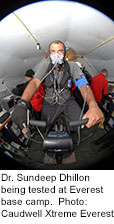- Skip Storing This Everyday Product in the Fridge Door
- Green Tea + B3 Pairing May Boost Brain Health
- Navigating Your Midlife Crisis: Embracing New Possibilities
- City Raccoons Showing Signs of Domestication
- Mapping the Exposome: Science Broadens Focus to Environmental Disease Triggers
- One Week Less on Social Media Linked to Better Mental Health
- Your Brain Changes in Stages as You Age, Study Finds
- Some Suicide Victims Show No Typical Warning Signs, Study Finds
- ByHeart Formula Faces Lawsuits After Babies Sickened With Botulism
- Switch to Vegan Diet Could Cut Your Greenhouse Gas Emissions in Half
Clues to Type 2 Diabetes Discovered on Mount Everest


Research conducted on climbers atop Mount Everest offers new insight into the biological triggers for type 2 diabetes.
Specifically, the British investigators learned more about how low oxygen levels in the body (hypoxia) may be linked with insulin resistance, a risk factor for diabetes. Insulin resistance occurs when cells in the body fail to respond to insulin, the hormone that regulates blood sugar levels.
Increases in several indicators of insulin resistance occurred when the climbers were exposed to hypoxia at high altitudes for six to eight weeks. These changes were linked with increased blood levels of markers of inflammation and oxidative stress, according to the study in the April 14 issue of the journal PLOS One.
“These results have given us useful insight into the clinical problem of insulin resistance. Fat tissue in obese people is believed to exist in a chronic state of mild hypoxia because the small blood vessels are unable to supply sufficient oxygen to fat tissue,” study leader Mike Grocott, a professor of anesthesia and critical care at the University of Southampton, said in a university news release.
Scientists were able to observe things in healthy people at high altitudes that normally are only seen in obese people at sea level, Grocott noted.
“The results suggest possible [treatments] to reduce progression towards full-blown diabetes, including measures to reduce oxidative stress and inflammation within the body,” added Grocott, who is head of the Critical Care Research Area within the Southampton National Institute for Health Research Respiratory Biomedical Research Unit.
During the Everest expedition in 2007, 24 people traveled to the mountain and were checked for blood sugar control, body weight changes and signs of inflammation at base camp, which was at an altitude of 5,300 meters (about 17,388 feet).
Half of the participants remained at base camp while the other half climbed Everest to a maximum altitude of 8,848 meters (29,028 feet). Measurements were taken in each group at week six and week eight of the trek.
The study was part of a research program examining hypoxia and human performance at extreme altitudes, in an effort to improve care of the critically ill and other patients where hypoxia is a primary problem.
“These exciting results give us a unique insight into the possible mechanism of insulin resistance in diabetes, and provide some clues as to where we should be thinking about focusing further research on novel treatments for this disease,” study co-author Daniel Martin, senior lecturer and honorary consultant at University College London division of surgery and interventional science, said in the news release.
“It also demonstrates the value of using healthy volunteers in studies carried out at high altitude to patients at sea level. Our high altitude experimental model for investigating every day illnesses that involve tissue hypoxia is a fantastic way to test hypotheses that would otherwise be very difficult to explore,” he added.
More information
The U.S. Department of Health and Human Services explains how to prevent type 2 diabetes.
Source: HealthDay
Copyright © 2025 HealthDay. All rights reserved.










